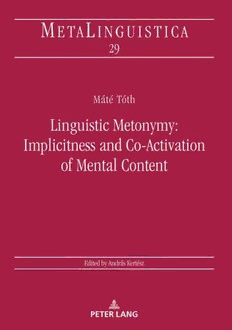
Linguistic Metonymy: Implicitness and Co-Activation of Mental Content PDF
Preview Linguistic Metonymy: Implicitness and Co-Activation of Mental Content
Linguistic Metonymy: Implicitness and Co-Activation of Mental Content METALINGUISTICA Herausgegeben von / edited by András Kertész BAND/VOLUME 29 Máté Tóth Linguistic Metonymy: Implicitness and Co-Activation of Mental Content Bibliographic Information published by the Deutsche Nationalbibliothek The Deutsche Nationalbibliothek lists this publication in the Deutsche Nationalbibliografie; detailed bibliographic data is available online at http://dnb.d-nb.de. Library of Congress Cataloging-in-Publication Data A CIP catalog record for this book has been applied for at the Library of Congress. Original title of the thesis: Delimiting and Classifying Metonymy: Theoretical and Empirical Challenges in Cognitive Metonymy Research Opponents (reviewers): Dr. Péter Pelyvás, Dr. Gábor Simon Supervisor: Dr. Péter Csatár University of Debrecen Doctoral School of Linguistics Programme for modern linguistics Cover Design: © Olaf Gloeckler, Atelier Platen, Friedberg ISSN 0946-4174 E-ISBN 978-3-631-77142-6 (E-PDF) E-ISBN 978-3-631-77143-3 (EPUB) E-ISBN 978-3-631-77144-0 (MOBI) DOI 10.3726/b14806 © Peter Lang GmbH Internationaler Verlag der Wissenschaften Berlin 2018 All rights reserved. Peter Lang – Berlin ∙ Bern ∙ Bruxelles ∙ New York ∙ Oxford ∙ Warszawa ∙ Wien All parts of this publication are protected by copyright. Any utilisation outside the strict limits of the copyright law, without the permission of the publisher, is forbidden and liable to prosecution. This applies in particular to reproductions, translations, microfilming, and storage and processing in electronic retrieval systems. This publication has been peer reviewed. www.peterlang.com For Réka and Sára Contents 1 Introduction ................................................................................................... 11 1.1 The pre-cognitive linguistic tradition ....................................................... 11 1.2 From the poor sister to ubiquity ............................................................... 12 1.3 Problems under scrutiny ............................................................................ 14 1.4 Metonymy in holistic cognitive linguistics .............................................. 15 1.5 (Pdel): Delimiting metonymy .................................................................. 18 1.6 (Pclass): Classifying metonymy .............................................................. 19 1.7 The relevance of (Pdel) and (Pclass) for the empirical study of metonymy .................................................................................................... 20 1.8 The structure of the book ........................................................................... 21 2 Metonymy in cognitive linguistics ....................................................... 23 2.1 Cognitive linguistics: basic tenets, goals, and commitments ................ 24 2.2 The cognitive view of metonymy .............................................................. 30 2.3 The ubiquity and primacy of metonymy ................................................. 36 2.4 Relating conceptual and linguistic metonymy ........................................ 42 2.5 Tendencies in research on metonymy ...................................................... 47 2.6 Summary ...................................................................................................... 53 3 Metonymy and metaphor ......................................................................... 55 3.1 The relationship between metonymy and metaphor in CL ................... 55 3.2 Definitional problems ................................................................................. 57 3.2.1 Intra-domain vs. inter-domain mappings ........................................ 59 3.2.2 Contiguity vs. similarity ..................................................................... 60 3.2.3 Domain highlighting vs. domain mapping ...................................... 64 3.3 The interaction of metonymy and metaphor .......................................... 67 8 Contents 3.4 The metonymic motivation of metaphor and the metonymy- metaphor continuum ................................................................................ 68 3.5 Barcelona’s schematic, unitary definition of metonymy ...................... 71 3.5.1 Degrees of metonymicity ................................................................ 72 3.5.2 Refinement of the notions of domain and contiguity .................. 73 3.5.3 Further examples ............................................................................. 75 3.6 A narrow approach: Warren’s alternative ............................................... 76 3.6.1 Referential and propositional metonymy ...................................... 77 3.6.2 Differences between metonymy and metaphor on the level of linguistic expressions ....................................................................... 80 3.6.3 Referential metonymy and metaphor ............................................ 80 3.6.4 A new look at earlier examples ....................................................... 83 3.7 Summary .................................................................................................... 86 4 Linguistic metonymy as implicit co-activation of mental content ............................................................................................................. 91 4.1 Introduction .............................................................................................. 91 4.2 On the referential nature of metonymy in CL ....................................... 92 4.3 Linguistic metonymy and a broad view of reference ........................... 100 4.4 Linguistic metonymy as co-activation of mental content .................... 106 4.5 The implicitness of linguistic metonymy ............................................... 111 4.6 Linguistic metonymy and related phenomena ...................................... 120 4.6.1 Linguistic metonymy and active zone phenomena ....................... 121 4.6.2 Linguistic metonymy and metaphor ............................................... 124 4.6.3 Linguistic metonymy in comparison and contrast ....................... 134 4.7 Some questions for future research ........................................................ 137 4.8 Summary .................................................................................................... 139 5 A content-based classification of metonymy ................................. 143 5.1 Introduction .............................................................................................. 143 Contents 9 5.2 Linguistic metonymy and the conceptual content activated ............... 145 5.3 A content-based classification of metonymy ......................................... 147 5.3.1 Thing-metonymies ........................................................................... 147 5.3.2 Event-metonymies ........................................................................... 151 5.3.3 Property-metonymies ..................................................................... 154 5.3.4 Proposition-metonymies ............................................................... 156 5.3.5 Speech act metonymies ..................................................................... 159 5.4 The content-based approach in comparison and contrast .................. 160 5.5 Summary .................................................................................................... 163 6 Empirical methods in cognitive metonymy research ................ 165 6.1 Introduction .............................................................................................. 165 6.2 Data and methods in cognitive metonymy research ............................ 166 6.2.1 Intuition and introspection .............................................................. 167 6.2.2 Contrastive and cross-linguistic investigations ............................. 169 6.2.3 Corpus-linguistic methods ............................................................... 171 6.2.4 Experimentation ................................................................................ 174 6.2.5 Interim summary ............................................................................... 175 6.3 Case study 1: An event-metonymy from a cross-linguistic perspective ................................................................................................. 175 6.3.1 The ICM of playing musical instruments ....................................... 177 6.3.2 Data from English, German, and Hungarian ................................ 178 6.3.3 Further languages .............................................................................. 181 6.3.4 Conclusion and methodological reflections .................................. 186 6.4 Case study 2: A corpus study of synesthetic expressions as property-metonymies ............................................................................ 188 6.4.1 Introduction ....................................................................................... 188 6.4.2 Synesthetic expressions as property-metonymies ...................... 192 6.4.3 Corpus and procedure ...................................................................... 197 6.4.4 Results of the analysis ....................................................................... 199 6.4.5 Discussion .......................................................................................... 201 6.5 Summary .................................................................................................... 203
